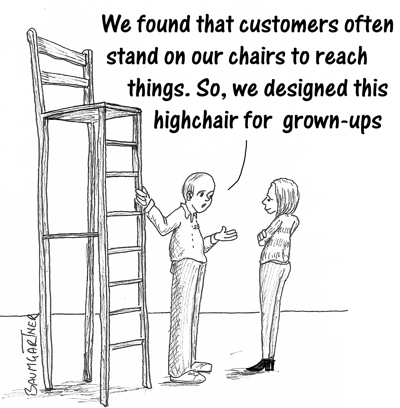
Why and How to Exploit Alternative Uses for Your Products
By Jeffrey Baumgartner
If you manufacture or distribute products, you probably have very clear ideas about how your products are used. However, the chances are, you are only partially right.
We human beings are great improvisers, especially when it can save us time. Consider the chair. It is mainly considered and designed to be sat upon. Nevertheless, people actually use chairs in all kinds of ways. The person who needs to reach something on top of a tall bookcase is likely grab the nearest chair. Chairs are often used as coat racks (with jackets draped over their backs) and occasionally as locks (jammed under a doorknob to prevent a door being opened) and even weapons (smashed over someone's head). For a child, a chair can be the seat of an imaginary racing car or rocket. Yet, few chair designers consider these alternative uses when designing new products. As a result, they are missing out on some interesting marketing opportunities.
Clearly, it would benefit you to know different ways people use − and could use − your products. There are three ways you can do this. First, if you use idea management software that allows you to post challenges, ask for suggestions of alternative uses of your products.
The second approach would be to create a marketing campaign in which you ask customers for unusual things they have done with your products and original uses for your products. Offer rewards for the most creative stories.
The third approach is to run a facilitated workshop, ideally including a diverse mixture of employees, customers, suppliers, young people and old people. Bring your products to the workshop and explore various uses. You will be surprised by the results.
Three Kinds of Outcomes
Irrespective of which approach you use to come up with ideas – and you can use more than one approach – there are three kinds of outcomes you may get. The first and most obvious one is that you discover new markets and new ways to market your products. A chair designer, for instance, might make a combination chair-mini-step-ladder for kitchens.
The second outcome is you discover that with simple modifications, your product could target a new market or could be made far more appealing to an existing market. For example, a children's chair with a detachable spaceship-like control panel would delight imaginative youngsters.
The third outcome is a bit more obscure, but could help you prevent your customers injuring themselves or worse – which can also save your firm from expensive and reputation damaging law suits. If people make product suggestions which are not only unsuitable for your product, but are also dangerous, you can provide product warnings on your packaging which can help prevent customers from injuring themselves and reduce your liability in the event customers do not read the warning labels.
Finding new uses for successful products and services can clearly increase your market size and, as a result, sales. Finding new uses for unsuccessful products and services, on the other hand, can turn a dud into a winner of a product.
R103/20170621




